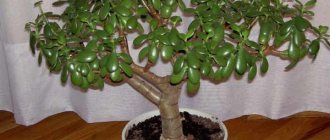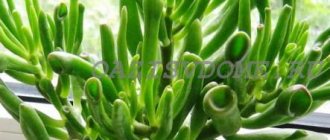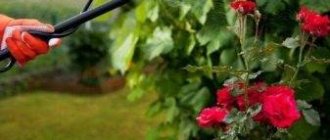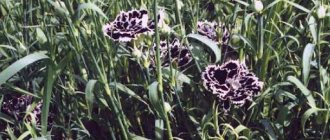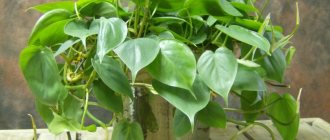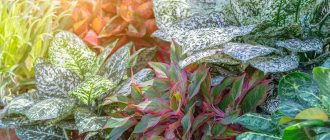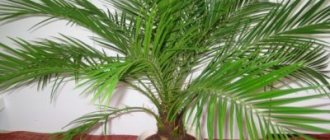general description
Crassula is a large genus of leafy succulents, most of which originate from the arid regions of South Africa. About 20 species are found in Australia, Tasmania, and other parts of the world.
Among the fat plants there are tree-like plants - with a trunk that hardens over time and a clearly defined crown; they are called money trees. But this is only a small part - the species and varieties are diverse, they can spread along the ground, form basal rosettes, rise above the ground to a small height and have no branches.
To survive in extreme conditions, stems and leaves sometimes take on bizarre shapes. Only specialists can understand the varieties of Crassula; amateurs can only determine the identity of the plants from photos with names.
But there are signs common to all species of the genus Crassula:
- thick leaves and shoots that store water for survival during dry periods;
- dense, shiny epidermis that prevents moisture transpiration;
- in the vast majority of varieties, the plates appear in pairs and are located oppositely;
- flowers are small, star-shaped;
- weak fibrous root.
Nurseries and greenhouses in Europe grow about 50 species of Crassula. But it is impossible to determine how many there are in the culture.
Cuttings from exotic countries are sent by mail and brought by tourists. They take root well, even if the stem is reduced to the state of a rag, they reproduce easily, and quickly disperse into cactus collections.
Tree Crassula
It is this group of Crassulas that is called money trees. They branch well, have a clearly defined central stem, which over time partially or completely hardens and is covered with cork tissue.
If desired, the fat plants can be given the appearance of a bush, but without pruning they will grow to look like a tree. These types of money tree are easy to form as a bonsai.
Ovata (Ovate)
Ovata grows in the Cape and Natal provinces (South Africa). This is the most common type of crassula in indoor floriculture, found on almost every windowsill.
At home it grows relatively quickly, with proper care, without restraining pruning, it reaches a height of 1-1.5 m. The trunk is woody, succulent, and branches well.
The leaves appear in crosswise arranged pairs. The Crassula plates are whole, thick, fleshy, rounded at the top, with a wedge-shaped base. In bright sunshine, a red rim appears along the edge.
In nature, Crassula Ovata blooms in winter. When grown in pots, biological rhythms are disrupted; pinkish-white buds collected in loose umbrellas appear extremely rarely, sometimes in the summer.
Crassula Ovate is considered one of the easiest plants to maintain. She needs diffused light, room temperature, a drained, nutrient-poor substrate. Ovata's greatest fear is that the roots will become soaked.
This variety of money tree has a huge number of varieties. The vast majority can only be seen by amateurs in photographs and purchased only from professional cactus growers who exchange propagation material.
The reason is that the species is plastic; selection is carried out by private individuals along with large firms; new varieties of Crassula Ovata appear constantly. Some are easy to confuse, but they are different from others:
- name;
- border width;
- the shape of monstrous leaves;
- location, size of color strokes.
For example, when breeding a cactus plant with a red-yellow border, a cactus grower receives a specimen in which most of the leaf is golden, and the scarlet stripe stretches only along the edge. It fixes the trait, and the new varietal variety is ready.
A little about variegated Crassulas
The white color on the leaves is the result of a genetic malfunction; in Ovata it appears more often than other fat plants. It can be fixed by vegetative propagation and a variety can be developed that is almost completely devoid of chlorophyll.
But amateurs who received a white Crassula cutting for rooting should not rejoice - it will not take root. The fact is that discolored vegetative organs exist at the expense of green ones.
The less chlorophyll in a plant, the worse they eat and receive less plastic substances. This is why variegated fatworts develop slowly, have small leaves and are very capricious.
Varieties with many white areas are difficult to care for. In the sun they burn, they suffer more from excess or lack of moisture, and in the shade the green areas expand. If agricultural practices are violated, dark spots appear on the variegated plates, which do not disappear after normal care.
Monstrous varieties
Crassula with leaves of an uncharacteristic shape for the species. Appeared as a result of a gene mutation, the original characteristics were fixed during vegetative propagation. The most famous varieties were obtained by crossing the Ovata and Mlechnaya fat plants:
- Gollum - the variety is called “Shrek ears”, the plates are fused, forming an expanding funnel at the ends;
- Hobbit - leaves are turned outward, connected by edges at the base or to the middle;
- Coral - the plates have turned into thick tubes, tapering at the ends, sometimes there is a small depression at the top;
- Red Horn is a variety of the Gollum variety; in good light, the funnels turn yellow-red.
Some of the leaves of Gollum and the Hobbit are the same as those of the Coral Crassula - they are not rolled into a ball expanding from the base, but look like sticks. For propagation, vegetative organs that best correspond to the varietal characteristics are taken.
Monstrous varieties of Crassula grow slowly and have a compressed crown. They are easier to shape into bonsai style.
Sunset
A striking variety with strokes of yellow or white in the center of the leaf and a red border around the edge. From a distance, the Crassula may appear pink. The original color appears only at high temperatures and bright light. In the shade, Crassula turns dirty green.
If the variety has been away from sunlight for a long time, the varietal characteristics may not return after being moved to a bright place.
Minor
A variety of Ovata Crassula, characterized by slow growth, short internodes, and small leaves. Known by the incorrect name Compacta.
The plates are up to 4 cm long and, in good light, acquire a reddish tint with a darker rim. Unpretentious, with strong immunity.
Oblikva
Crassula ovata var. Obliqua is a natural variety, characterized by a triangular pointed top, curved surface:
- the tip is directed vertically;
- the sides are slightly drooping.
Because of this, the leaf appears to grow upward, and not perpendicular to the trunk, as in the species Crassula Ovata.
There are two variegated varieties, the color intensity of which depends on the lighting:
- Solana is unevenly painted with yellow or white strokes;
- Tricolor - the edges and back of the plate are pink or reddish, in the center there are variegated stripes.
Tree-like
- Arborescens is endemic to the Western Cape (South Africa). The species is less common and more capricious than Crassula Ovata: it is demanding of light and tolerates waterlogging less well. In cultivation it grows up to 1.5 m, the trunk is woody, succulent, branched, the leaves are almost round, up to 7 cm long and 5 cm wide.
The plates are fleshy, greenish-gray in color, with a thick epidermis, located in the same way as in the Ovata Crassula:
- two opposite leaves emerge from one node;
- relative to the nearest pairs they are shifted by 45°.
With sufficient lighting, the plates are reddish along the edge and from the inside. The stomata are clearly visible - whitish dots are scattered over the entire surface. At home, Crassula rarely blooms and is used to create bonsai.
There is a natural variety called undulatifolia with thinner, silver-blue leaves that have a slightly wavy edge. There is a variegated form and the Blue Bird variety. The latter has a more saturated color, the plates curl more strongly.
Sarcocaulis
Sarcocaulis, a species popular in America and Western Europe, is not yet widespread in the post-Soviet space. It is distinguished by a curved trunk and small leaves, which is why it received the name Crassula bonsai.
It is a small shrub with a woody central shoot; in cultivation it reaches a height of 50 cm.
The leaves are juicy, green, narrow, and from a distance they resemble pine needles. Purple buds and pink flowers rarely appear at home.
Columnar species of Crassula
These Crassulas look nothing like money trees. The central stem is single or poorly branched. The group includes species that really look like a column, or grow vertically. The latter sometimes reach a great length without pruning, hang, turning into ampelous ones.
The leaves of columnar (spike-shaped) Crassula are opposite, thick, the bases clasp the stem and grow together. They are compact in size and form dense clumps over time.
Hairy
Pubescens can, depending on the variety, be classified as both columnar and groundcover crassulas. It is a succulent that at a young age resembles a rosette with a shortened stem; over time it turns into an erect, weakly branching bush. In nature it reaches 40 cm, much lower when grown at home.
The species attracts attention with its pubescent thick leaves up to 3 cm long. The shape is elongated-oval, widening towards the end. The peduncle rises above the rosette.
There are 3 varieties:
- pubescens – velvety plant, the description matches the main species;
- radicans - with smooth thin leaves and lodging shoots;
- rattrayi is practically never found in cultivation.
Rocky (Broad-leaved)
Rupestris is a picturesque common type of Crassula that grows and forms a dense clump. The shoots are erect, fleshy, branched, reach 60 cm without pruning, droop, and become ampelous.
The leaves are bluish-green, becoming reddish along the edges in bright sun. The plates of the Crassula appear triangular, but are actually oval with a sharp end, the base encircling the stem. Length from 1 to 2.5 cm with a width of 1-2 cm.
Buddha Temple
C. Buddha`s Temple is one of the most spectacular and original cultivated crassulas. The plant of the species is a slender column assembled from leaves resembling squares with corners turned up. The plates are pressed tightly against each other, in fact they are oval at the base, up to 2.5 cm wide
When viewed from above, the Crassula resembles a stylized cross or pagoda and grows at a rate of 3-5 cm per year. Over time, the main stem lengthens and bends, which only adds to the exotic look.
Creeping Crassula species
The group includes fat plants with soft lodging shoots, growing quickly and occupying a large space. They can be grown separately in wide flat pots, included in compositions, or planted as a cover plant to large succulents.
Mossy (mossy)
Muscosa, synonym Lycopodioides, may belong to the previous group. A popular species with a shallow root system. The shoots are thin, soft, and due to the many small lettuce leaves clasping the stems, they appear tetrahedral.
The young plant stretches upward, the adult forms a chaotic bush 15-20 cm high, producing tiny greenish-yellow flowers. Often forms roots on shoots. Shade-tolerant, undemanding species, easily propagated, develops quickly, and literally falls out of the pot after a few years.
Milky
C. Lactea in cultivation reaches a maximum of 30 cm. It is an ampelous plant with brownish shoots, obovate leaves, pointed at the end, 3-4 cm long, 2-3 cm in cross section.
The plates are soft green and fleshy. The peculiarity of the species is that white dots of salt from the evaporated liquid protrude along the edge.
Crassula is very easy to grow, suitable for beginners. She is one of the ancestors of the famous monstrous varieties of fat girls Gollum and Hobbit.
Spot
C. picturata is distinguished by lodging, well-branched stems. The leaves are small, 15 mm long, 8 mm wide, green. The front part of the plate is covered with red specks, the reverse – purple.
Grouped
C. socialis is a type of groundcover Crassula. Thin soft shoots branch strongly, spread, the ends are raised, which is why it seems that many tiny rosettes are growing in the pot.
Flat lettuce leaves, the tip of which forms an obtuse angle, reach 5 mm in length, decorated with almost imperceptible thin cilia that extract moisture from the air. Crassula of this species grows quickly, sometimes producing small pinkish-white flowers.
Cooper
C. Cooperi is a fat plant with lodging stems up to 15 cm long. The leaves have a sharp tip, are surrounded by villi along the edges, and grow in a spiral. The color is silver with light green specks and a rim.
There is a variety of Crassula cooperi Regel with a brown-green background and purple spots.
Reproduction
Propagated by cuttings and seeds.
Propagated by cuttings using stems or leaves. The shoot or leaf is cut with a sharp knife. Leave the cut cuttings to dry for 2-3 days, and then plant them in a wide container with prepared soil and drainage. You can plant cuttings immediately. But for this, the cut site is treated with wood ash or ground activated carbon.
Seeds are sown in a flat container. Add another portion of sand to the soil before sowing. Cover the container with glass or plastic film and spray the soil daily. After a sprout with 2-3 leaves appears , the young sprout is transplanted into a separate pot.
Decorative flowering species of Crassula
This is how the group can be called conditionally; in fact, all Crassulas produce buds, they just do it reluctantly in apartments. The varieties described below often produce flower stalks in pots if maintained correctly.
Typically, flowering time occurs in winter. But, if the fat plant is placed outside in the spring, buds may appear at the end of summer.
Crescent
C. Falcata is an interesting species with decorative leaves and flowers. Crassula is a plant with a slightly branched straight stem and large, up to 10 cm, fleshy leaves covered with a bluish coating. It got its name due to the shape of the elongated plates. Umbrella inflorescences are dense, up to 20 cm in diameter, red-orange.
In nature, the height of the Crassula reaches a meter; when grown at home, it is much less. Moreover, after the buds wither, the crassula is cut down to the first developed leaf. When side shoots appear, they are separated and rooted, the rest of the plant is cut into cuttings.
Schmidt
C. Schmidtii - the species can be classified as a ground cover Crassula. Widely distributed in Europe, grown as an annual for its beautiful flowers. Refers to bouquet plants - after the buds wither, they are usually thrown away.
Crassula Schmidt forms a dense, low (up to 10 cm) bush with light green leaves, reddish on the inside. They are fleshy, narrow, elongated, pointed at the end, the stems have a pink tint.
Carmine flowers. There are varieties that differ in the color of the leaves or with raspberry buds.
Perforated
Perforata grows up to 20 cm, the stems are uneven, hard, erect. Every year, usually in winter, but sometimes from June to October, white, pink or red inflorescences appear at the ends of Crassula shoots.
But the main attraction of the species is the rhombic leaves, up to 2 cm long, fused at the base and covering the shoots. They are a delicate light green color with a silver or olive bloom; in bright light, the outer side is often dotted with red dots.
The Perforata species is an easy-to-care, unpretentious Crassula that can be easily propagated by pieces of shoots. Can be grown as a hanging plant.
